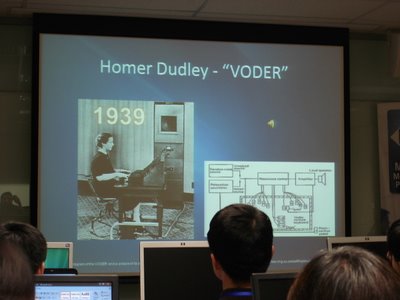Today we heard from Nicholas White from Redmond. Nick has an interesting role in that he works with all Non Traditional Media, i.e. like this blog! He is a great guy that some of you may recognise (virtually) as the author of the WindowsVistaBlog.com and an active organiser on The Hive. While the Vista blog is not overly "techy" it does delve into some subjects quite well. A white paper that Nick wrote really caught my attention regarding Direct X 10 (DX10) so if youre interested and want to read more on Direct X 10 go to this white paper. DX10 will ONLY be available on Vista and will ship as part of a Windows Update shortly (not sure if Im allowed to say that).
Richer scenes and complex environments
Picture 6: Windows Vista wallpaper rendered in DirectX9
Picture 7: Windows Vista wallpaper rendered in DirectX10
Then there was a surprisingly enthusiastic presentation by Microsoft Chinas DPE General Manager named Nigel Burton. He gave a personal account of major Corporations and Chinese Companies working to develop "rich" mobile user experiences. I am not sure how NDA this is so I will not go into it further however if you are a developer and think you have a killer application for a mobile device then maybe contact Nigel as he has an active market place waiting for you!
For me, the highlight of the day was Binggong Don, of Microsoft China, who gave a great talk on Text-to-Speech (TTS) in Windows Vista. While Windows XP only had one language supported (English) it seems that TTS has added Chinese too. XP had a voice in it called Sam while Vistas launch will see Anna added and in Chinese our Asian counterparts will get a chance to hear from Lili! Here is brief history of TTS up to the present date:
 Seems like TTS has been of interest for a long time...way before Vista
Seems like TTS has been of interest for a long time...way before Vista
- 1791: Speaking Machine was invented
- 1939: Homer Duley Electronic Processing Sound Machine
- 1992: Speech Team Created
- 1998: Product Group Formed
- 2000: Division-level investment (SAM, Worked on XP)
- Today: shipped fully packed in Vista, brand new TTS engine in Windows Vista. Microsoft China innovated next wave of TTS system.
The interesting thing about TTS I that it is not created by a massive database of words stored and cut/pasted together. Firstly it is created by Text Analysis, then Unit Selection and finally Wave Generation. In the first portion the word needs to be broken down into pronunciation and Normalization. The second portion of the equation takes the best "most suitable" candidate of each sound, then places it into a combination of sounds that help generate the intended word , e.g. an "E" sound may differ dramatically in different words, so via the above mentioned algorithm TTS plays a role in judging how and when to best describe that "E". Finally the wave generation portion takes into account the word formation as best practice while forming Sounds Waves, i.e. inflections.
You think that sounds complicated?!?! You try explaining it! LOL...OK guys, Im off to bed after having a banquet/feast at a very classy restaurant! Let me know if you want me to chase anything else up for you.


0 comments:
Post a Comment